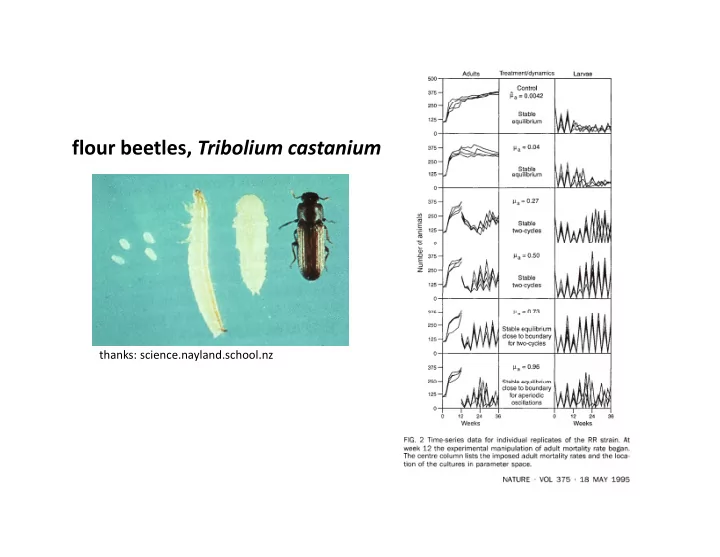

flour beetles, Tribolium castanium thanks: science.nayland.school.nz
Some important distinctions Cohort life table: Follow the fate of a group of individuals all born during the same time interval (a k a longitudinal born during the same time interval. (a.k.a. longitudinal data) Segment life table : Follow all individuals alive during the same time interval. (a.k.a. static life table)
Some important distinctions Birth ‐ flow : Births occur continually Birth ‐ pulse: Births occur once per time step, and at a common point in time. For birth ‐ pulse populations, we further distinguish between: pre ‐ breeding census: births occur immediately after parents graduate to a new age class post ‐ breeding census: births occur immediately before parents graduate to a new age class
Definitions and notation S( ) F S(x) : For a cohort life table, the number of individuals that h lif bl h b f i di id l h survive to age x. S(0): Initial size of cohort. k : Age by which all individuals have died k : Age by which all individuals have died. Survivorship, l(x): Fraction of cohort that survives to age x (i (i.e., cumulative survival) l i i l) S x ( ) l x ( ) S S (0) (0) Survival rate, g(x) : Fraction of cohort alive at age x that survives to age x+1. survives to age x+1 S S x ( ( 1) 1) g x ( ) S x ( )
Definitions and notation Survivorship can also be defined in terms of survival rate: l x ( ) g (0) g (1) g x ( 1) Some authorities (but not Populus) define the mortality rate as m x m x ( ) ( ) 1 1 g x g x ( ) ( ) Fecundity, b(x) (alt. maternity, m(x) ): The average number of female offspring born per unit time to an individual female parent of age x.
Calculations (assuming a post ‐ breeding, birth ‐ pulse population) Survivorship, l(x), and fecundity, b(x), schedules yield: net reproductive rate, R 0 : average number of female offspring produced per female parent over her lifetime k k R l x b x ( ) ( ) 0 x 0 generation time, G: average age of the parents of all generation time G: average age of the parents of all offspring (at the time of their births) produced by a single cohort. k k l x b x x ( ) ( ) x 0 G R R 0
x S(x) b(x) l(x) g(x) 0 100 0 1 1 90 90 0 0 2 80 1 3 40 3 4 0
x S(x) b(x) l(x) g(x) 0 100 0 1 0.9 1 1 90 90 0 0 0 9 0.9 0 89 0.89 2 80 1 0.8 0.5 3 40 3 0.4 0 4 0 0
Calculations (assuming a post ‐ breeding, birth ‐ pulse population) Survivorship, l(x), and fecundity, b(x), schedules yield: instantaneous rate of population increase, r, or population multiplication rate, . Same as before. Given “implicity” by the Euler equation: by the uler equation: k rx 1 e l x b x ( ) ( ) x 0 k x 1 l x b x ( ) ( ) x 0
Recommend
More recommend